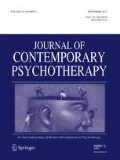Abstract
The purpose of this paper is to discuss the practice of recommending movies for clients to watch to assist them with their presenting complaints. Movies may be an efficient means of working with some clients who are difficult to reach emotionally through other methods. They also provide a powerful means of observational learning with opportunities to choose among different attitudes and behaviors. The pros and cons of this intervention are discussed, as well as initial suggestions on incorporating films into clinical practice. A cautious approach is recommended, as a systematic series of empirical investigations should be undertaken to more effectively inform clinical practice. Examples of areas to target for future research are provided.
Similar content being viewed by others
References
Bausell, R. B. (1994). Conducting meaningful experiments: 40 steps to becoming a scientist. Thousand Oaks, CA: Sage.
Bertolino, B. (1999). Therapy with troubled teenagers: Rewriting young lives in progress. New York: John Wiley & Sons, Inc.
Bertolino, B. (2001). Lights, camera, action!!! Making new meanings through movies. In H. G. Rosenthal (Ed.), Favorite counseling and therapy homework assignments: Leading therapists share their most creative strategies (pp. 43–46). Philadelphia, PA: Taylor & Frances.
Boggs, J. M. (1991). The art of watching films (3 rd ed.). Mountain View, CA: Mayfield Publishing Company.
Cocks, G. (1991). Bringing the Holocaust home: The Freudian dynamics of Kubrick's The Shining. Psychoanalytic Review, 78, 103–125.
Craighead, L. W., Craighead, W. E., Kazdin, A. E., & Mahoney, M. J. (1994). Cognitive and behavioral interventions: An empirical approach to mental health problems. Boston, MA: Allyn and Bacon.
Dermer, S. B., & Hutchings, J. B. (2000). Utilizing movies in family therapy: Applications for individuals, couples, and families. The American Journal of Family Therapy, 28, 163–180.
Dryden, W. (1999). Rational emotive behavior therapy: A training manual. New York: Springer Publishing Company.
Eisenberg, M. (1985). Rehumanizing university teaching. The International Forum for Logotherapy, 8, 44–46.
Finck, W. C. (1992). The Kane syndrome. The International Forum for Logotherapy, 15, 30–32.
Frankl, V. E. (1988). The will to meaning: Foundations and applications of logotherapy (Exp. ed.). NY: Meridian.
Frueh, B. C. (1995). Self-administered exposure therapy by a Vietnam veteran with PTSD. American Journal of Psychiatry, 152, 1831–1832.
Glasser, W. (1998). Choice theory: A new psychology of personal freedom. New York: HarperPerennial.
Glasser, W. (2000). Reality therapy in action. New York: Harper Collins.
Greenberg, H. R. (1993). Screen memories: Hollywood cinema on the psychoanalytic couch. New York: Columbia University Press.
Hesley, J. W., & Hesley, J. G. (1998). Rent two films and let's talk in the morning. New York: John Wiley & Sons, Inc.
Heston, M. L., & Kottman, T. (1997). Movies as metaphors: A counseling intervention. Journal of Humanistic Education and Development, 36, 92–99.
Kottler, J. A. (1993). On being a therapist (Rev. Ed.). San Francisco, CA: Jossey-Bass Publishers.
McLeod, J. (1997). Narrative and psychotherapy. London: Sage Publications.
Moore, C. (1998). The use of visible metaphor in logotherapy. The International Forum for Logotherapy, 21, 85–90.
Mounteer, C. A. (1992). The religious experience of modern American film. The Journal of Psychohistory, 20, 53–63.
Nunnally, J. C., & Bernstein, I. H. (1994). Psychometric theory (3 rd ed.). New York: McGraw-Hill.
Paden-Levy, D. (2000). Finding logotherapy in today's popular culture. The International Forum for Logotherapy, 23, 95–100.
Payne, M. (2000). Narrative therapy: An introduction for counsellors. London: Sage Publications.
Rosenthal, T. L., & Steffek, B. D. (1991). Modeling methods. In F. H. Kanfer & A. P. Goldstein (Eds.), Helping people change: A textbook of methods (4 th Ed., pp. 70–121). Boston, MA: Allyn and Bacon.
Solomon, G. (1995). The motion picture prescription: Watch this movie and call me in the morning. Santa Rosa, CA: Aslan Publishing.
Solomon, G. (2001). Reel therapy: How movies inspire you to overcome life's problems. New York: Lebhar-Friedman Books.
Terr, L. C. (1989). Terror writing by the formerly terrified: A look at Stephen King. Psychoanalytic Study of the Child, 44, 369–390.
Welter, P. R. (1995). Logotherapy-Intermediate “A”: Franklian psychology and logotherapy. The Viktor Frankl Institute of Logotherapy, Box 15211, Abilene, TX 79698–5211.
Author information
Authors and Affiliations
Rights and permissions
About this article
Cite this article
Schulenberg, S.E. Psychotherapy and Movies: On Using Films in Clinical Practice. Journal of Contemporary Psychotherapy 33, 35–48 (2003). https://doi.org/10.1023/A:1021403726961
Issue Date:
DOI: https://doi.org/10.1023/A:1021403726961




